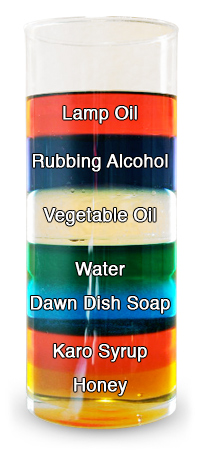 Ours consisted of 4 liquids: light corn syrup (sunk to the bottom), dish soap, water dyed red, and the vegetable oil settled on the top! Pretty neat! I was babysitting when we did this, and couldn't remember all of the layers, but it still made the point.
Ours consisted of 4 liquids: light corn syrup (sunk to the bottom), dish soap, water dyed red, and the vegetable oil settled on the top! Pretty neat! I was babysitting when we did this, and couldn't remember all of the layers, but it still made the point.
The following information is from: http://www.stevespanglerscience.com/experiment/seven-layer-density-column
How does it work?
The same amount of two different liquids will have different weights because they have different masses. The liquids that weigh more (have a higher density) will sink below the liquids that weigh less (have a lower density).
| Material | Density |
|---|---|
| Rubbing Alcohol | .79 |
| Lamp Oil | .80 |
| Baby Oil | .83 |
| Vegetable Oil | .92 |
| Ice Cube | .92 |
| Water | 1.00 |
| Milk | 1.03 |
| Dawn Dish Soap | 1.06 |
| Light Corn Syrup | 1.33 |
| Maple Syrup | 1.37 |
| Honey | 1.42 |
To test this, you might want to set up a scale and measure each of the liquids that you poured into your column. Make sure that you measure the weights of equal portions of each liquid. You should find that the weights of the liquids correspond to each different layer of liquid. For example, the honey will weigh more than the Karo syrup. By weighing these liquids, you will find that density and weight are closely related.
** NOTE: The numbers in the table are based on data from manufacturers for each item. Since each manufacturer has its secret formula, the densities may vary from brand to brand. You’ll notice that according to the number, rubbing alcohol should float on top of the lamp oil, but we know from our experiment that the lamp oil is the top layer. Chemically speaking, lamp oil is nothing more than refined kerosene with coloring and fragrance added. Does every brand of lamp oil exhibit the same characteristics? Sounds like the foundation of a great science fair project.
The table shows the densities of the liquids used in the column as well as other common liquids (measured in g/cm3 or g/mL).
Density is basically how much "stuff" is smashed into a particular area... or a comparison between an object's mass and volume. Remember the all-important equation: Density = Mass divided by Volume. Based on this equation, if the weight (or mass) of something increases but the volume stays the same, the density has to go up. Likewise, if the mass decreases but the volume stays the same, the density has to go down. Lighter liquids (like water or rubbing alcohol) are less dense than heavy liquids (like honey or Karo syrup) and so float on top of the more dense layers.


No comments:
Post a Comment